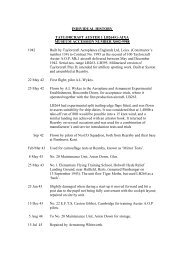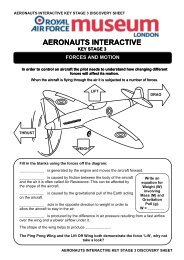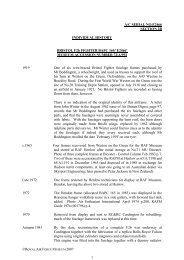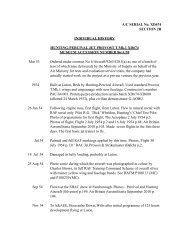Bomber Command Hall - RAF Museum
Bomber Command Hall - RAF Museum
Bomber Command Hall - RAF Museum
You also want an ePaper? Increase the reach of your titles
YUMPU automatically turns print PDFs into web optimized ePapers that Google loves.
TEACHERS RESOURCES – WORLD WAR II AIRC<strong>RAF</strong>T<br />
THE FOCKE WULF FW190A-8/U-1<br />
Location: To the left of the Lancaster bomber, as you look at its nose.<br />
The Focke Wulf was one of the most successful combat aircraft flown during World War II; being<br />
superior to the Spitfire V, the Luftwaffe had the advantage until the first Spitfire IX in July 1942.<br />
The Fw190 proved to be fast, strong and heavily armed with good all round vision and excellent<br />
ground handling. Although it was more advanced than the Messerschmitt Bf109, they operated<br />
side by side as day fighters on all German fronts. As higher performance was demanded of the<br />
Fw190 it was quickly fitted with bomb racks for fighter-bomber work.<br />
As a fighter-bomber it proved itself to be<br />
very adaptable and was used for:<br />
• Hit and run bombing<br />
• Ground attack<br />
• Torpedo attack<br />
• Tactical reconnaissance<br />
THE VICKERS WELLINGTON X<br />
Location: To the right of the Lancaster – adjacent to the Milestones of Flight tunnel.<br />
The two-engine Wellington bomber, introduced into service in 1938, formed the backbone of<br />
<strong>Bomber</strong> <strong>Command</strong> and was Britain’s most effective night bomber until the introduction of fourengine<br />
bombers in 1941.<br />
The Wellington was renowned for the large amount of damage that it could withstand. It was<br />
immensely strong as a result of the geodetic type of construction developed by Barnes Wallis.<br />
Although originally designed as a bomber, the<br />
Wellington also proved effective as a torpedo carrier<br />
and submarine killer in Coastal <strong>Command</strong>, before<br />
moving on to Transport and Training <strong>Command</strong>s.<br />
The Wellington dropped the first 1,880kg ‘Blockbuster’ bomb during the Emden raid of 1941.<br />
THE HANDLEY PAGE HALIFAX II<br />
Location: At the back of the <strong>Bomber</strong> hall behind the Wellington.<br />
The Handley Page Halifax was the second British four-engine bomber to enter service during<br />
World War II and the first to bomb Germany, as part of the Hamburg night bombing raids, on 12-<br />
13 March 1941.<br />
The Halifax was easy to fly, much faster than the Wellington and possessed a good range and<br />
bomb load which meant that it was second only to the Avro Lancaster bomber.<br />
Unfortunately, as it lacked adequate defensive fire power it<br />
suffered heavy losses in <strong>Bomber</strong> <strong>Command</strong> operations over<br />
Germany and was gradually restricted to less hazardous<br />
targets from September 1943. Later in the war, the Halifax<br />
was withdrawn from <strong>Bomber</strong> <strong>Command</strong> and used as mine<br />
layers and torpedo bombers in Coastal <strong>Command</strong>.<br />
Explore<br />
Further<br />
There are 4 other World War II aircraft in the <strong>Bomber</strong> <strong>Hall</strong>: the Heinkel He 162A-2,<br />
the Airspeed Oxford 1, the Avro Anson 1 and the North American TB-25 J Mitchell.<br />
Basic information about these aircraft can be found on our website<br />
www.rafmuseum.org/london<br />
TEACHERS RESOURCES – WORLD WAR II AIRC<strong>RAF</strong>T












